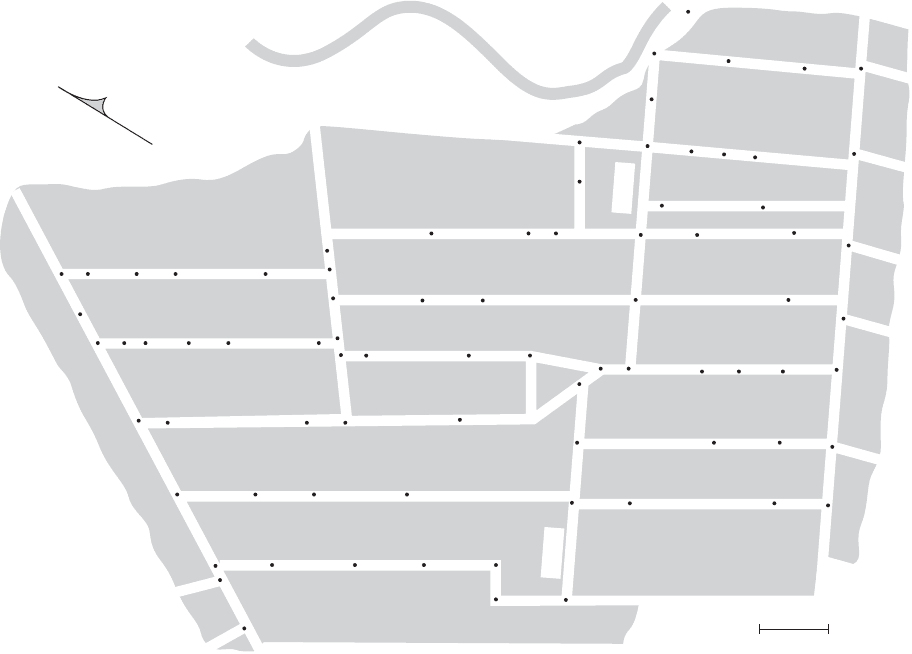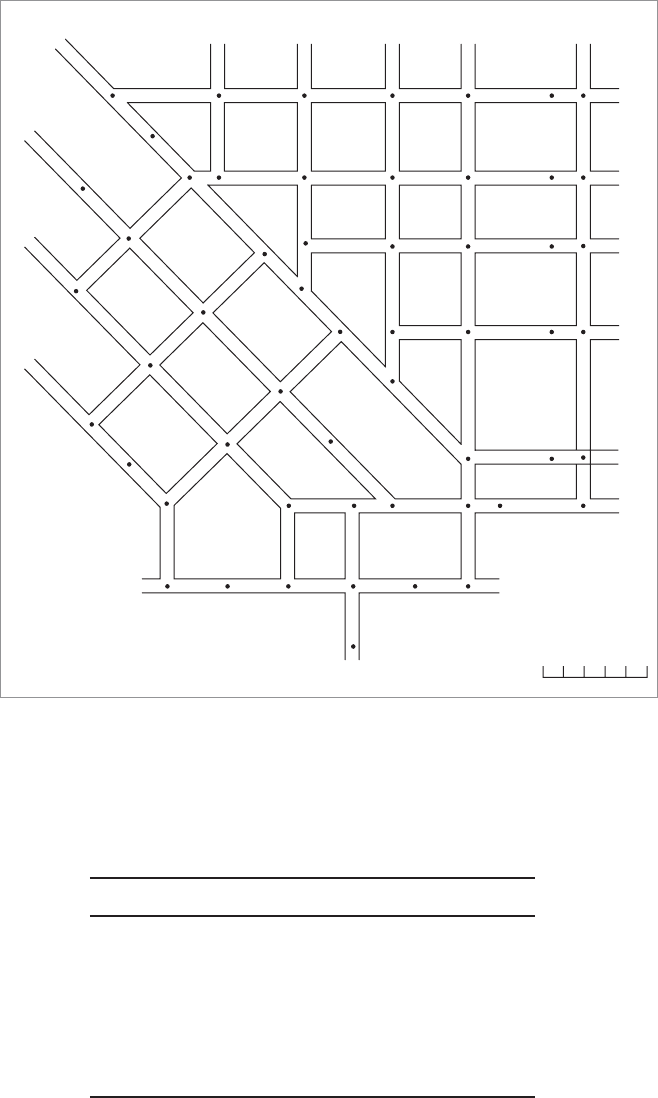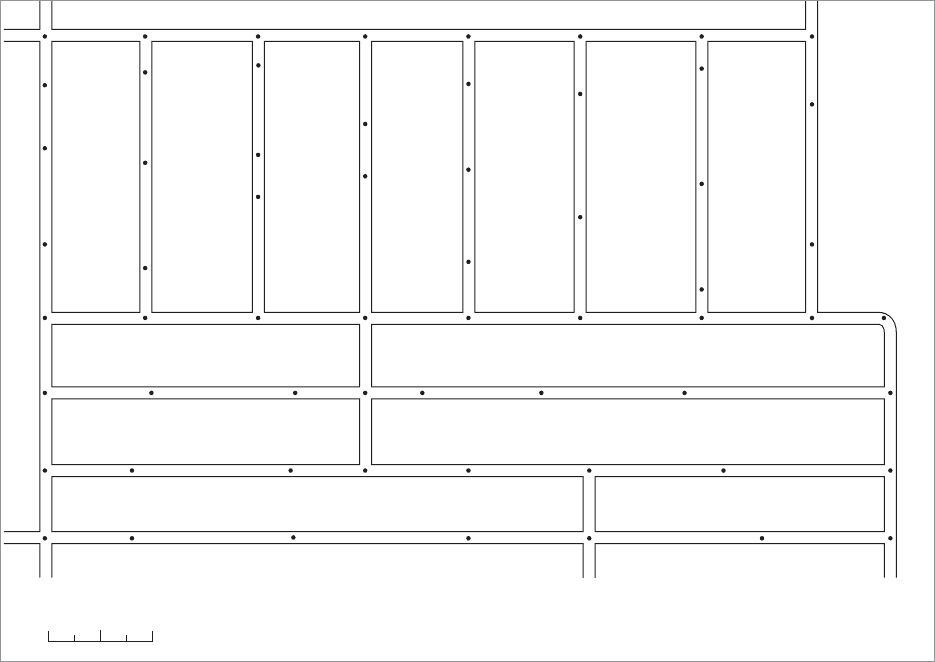Water and Wastewater Engineering
Подождите немного. Документ загружается.

19-40 WATER AND WASTEWATER ENGINEERING
Periodic video surveillance of the sewer is one method to establish the condition of the
sewer. When repairs are performed before failure of the sewer, cured-in-place pipe (CIPP)
may be appropriate. Typically, installing CIPP involves introducing a nonwoven-fiber felt liner
tube impregnated with a thermosetting resin into an existing pipe. No excavation is required
( Lindsey, 2007).
19-7 SEWER SAFETY
The Occupational Safety and Health Administration (OSHA) defines a confined space a s one
that has limited or restricted means for entry or exit, is large enough for an employee to enter and
perform work, and is not designed for continuous occupancy by the employee. The following are
classified as confined spaces: a
sewer manhole, a lift station wet well, a prefab pumping station
dry well. They are a safety hazard primarily because of the potential for accumulation of toxic
and explosive gases. The list of specific toxic gases includes but is not limited to carbon dioxide
(in quantities sufficient to di
splace oxygen and cause asphyxiation), carbon monoxide, chlorine,
hydrogen sulfide, and sulfur dioxide. The explosive gases include carbon monoxide, gasoline,
hydrogen, hydrogen sulfide, methane, and ammonia (Macy et al., 1980).
OSHA s pecifies the rules for entering a confined
space. Table 19-9 lists appropriate equip-
ment for entering a manhole. Among the many precautions for working in a sewer manhole,
a lift station wet well, or a prefab pu mping station dry well, the following three are held up
as vital:
• Never work alone. Preferably, the crew should consist of three people, one of whom stays
topside at all times.
• Check the atmosphere before entering —even if there has never been a problem before or
“It is always ok.” At lea
st one fatality occurs each year because of this assumption.
• Use a safety harness and have a tripod and hoist topside. Entrance and egress are difficult
enough without injury or incapacitation. It is virtually impossible for a rescue person to
carry another individual out.
• Man-lift. If the dry well is 7.5 to 9m deep, a powered
man-lift should be part of the
design.
Another safety issue is manhole covers. The standard manhole cover has a mass between
110 and 135 kg. A heavy duty manhole cover may have a mass up to 300 kg. Improper han-
dling m ay result in a lower back disorders, muscle injury, or in the wor
st ins tances crushed or
severed fingers and toes. Although a pry bar and J-hook are normal components of the work
crew’s gear, another useful tool is a long-handle, round-blade shovel with about 5 cm of the tip
removed. With the shovel blade placed between the manhole and the frame, the long lever arm
of the shovel makes it easy to release the manhole from the fra
me. The m anhole cover should
never be c arried by hand or otherwise maneuvered with one’s hands. The pry bar or J-hook
should be used to drag it away from the manhole. Likewise, in returning the cover, it should be
maneu vered back near the manhole with the pry bar or J-hook and then maneuvered over the
manhole with the heel of the worker’s steel-toed boots. It shou
ld never be maneuvered with
one’s hands. There is no need to be concerned about it falling in the manhole. It is round. It
will not fall in.

SANITARY SEWER DESIGN 19-41
19-8 CHAPTER REVIEW
When you have completed studying this chapter, you should be able to do the following without
the aid of your textbook or notes:
1 . Name the types of sewers (lateral, main, etc.) on a map with a sewer plan layout.
2. Name the parts (bell, spigot, etc.) of a sewer pipe.
TABLE 19-9
Personal protective equipment (PPE)
1. Hard hats
2. Rain suits
3. Hip boots
4. Rubber gloves
5. Leather gloves
6. Overalls
7. Goggles
8. Chest harness belt with safety rope
9. Extra rope
10. First-aid kit with blanket
11. Fire extinguisher
12. Tripod and hoist
13. Ladder
14. Combustible gas and oxygen content detector.
15. Toxic gas monitor and oxy
gen content detector.
16. Air packs, air tanks, hose
17. Forty-five-minute self-contained air packs for emergency rescue
18. Five-minute egress escape air pack
19. Portable air blower, 3 hp. 1,750 cfm
20. Portable electric generator, four outlets
21. Electric lamp
22. Portable lamp
23. Flashlights
24. Tool hoisters
25. “Men working” s
igns
26. Traffic cones
27. Vehicle beacon warning light
28. Barricade with beacon
29. Reflective traffic vests
30. Mirrors
31. Steel toed boots
32. J-hook
33. Long handle shovel
34. Cell phone/radio
Adapted from Macy et al., 1980.
Visit the text website at www.mhprofessional.com/wwe for supplementary materials
and a gallery of photos.
19-42 WATER AND WASTEWATER ENGINEERING
3. Name the parts of a manhole.
4. Sketch a drop manhole and explain why and where it may be used.
5. Explain the purpose of a lift station and give examples of when it is appropriate to use
them.
6. Explain the purpose of an inverted siphon and give examples of when it is appropriate
to use one.
7. Define the following abbreviations and terms: ROW, MH, SDG, STEP, GP, force
main, wet well, dry
well.
8. Explain what crown corrosion is, the circumstances that promote its occurrence, and
design techniques to minimize it.
9. Explain the logic behind the following design criteria: minimum pipe size, minimum
velocity.
10. Explain the need for estimating the velocity of wastewater in a pipe that is
flowing less
than full or half full.
11. Explain what an alternative sewer is and the circumstances that warrant their
consideration.
12. List the three vital safety precautions for entering sewers.
13. Describe safe techniques for removing and/or replacing a manhole cover.
W ith the aid of this text, you should be able to do the following:
14. Sketch the layout of a sewer on a topographi
c map.
15. Use Manning’s equation to estimate the slope, velocity, or capacity of a pipe given the
other appropriate variables.
16. Estimate the velocity of flow in a pipe flowing partially full.
17. Given a topographic map and sewage flow rates, design a sequence of reaches of a
sewer main.
18. Design a force main and select an appropriate pump for a small lift station.
19. Design the wet well volume of a wastewater pumping station given the pump
characteristics and peak hourly flow rate.
19-9 PROBLEMS
19-1. Table 19-2 suggests that the minimum slope for a flow rate of 0.019 m
3
/ s is 0.0033
using Manning’s equation with n 0.013. Show by computation that this wastewater
flow rate in a 350 mm diameter VCP on the minimum slope for the 350 mm diameter
will not achieve 0.6 m
3
/ s.
19-2. It has been proposed that the low velocity in Problem 19-1 can be raised to the
minimum velocity of 0.6 m/s by switching to PVC pipe. Show by calculation
whether or not this is true.

SANITARY SEWER DESIGN 19-43
19-3. Write an equation that will allow calculation of v / v
full
from a value of Q / Q
full
rather than reading from Camp’s hydraulic elements graphs for the condition when
n constant. The equation is to be for the region Q / Q
full
from 0.02 to 0.988. The R
2
value for the equation must be 0.999 for a satisfactory solution. Use the data from
Fair and Geyer (1954) given below.
Q/Q
full
v/v
full
0.988 1.14
0.838 1.12
0.671 1.072
0.500 1.00
0.337 0.902
0.196 0.776
0.088 0.615
0.021 0.401
19-4. Write an equation that will allow calculation of v / v
full
from a value of Q / Q
full
rather than reading from Camp’s hydraulic elements graphs for the condition when
n variable. The equation is to be for the region Q / Q
full
from 0.017 to 0.879. The
R
2
value for the equation must be 0.999 for a satisfactory solution. Use the data
adapted from Fair and Geyer (1954) given below.
Q/Q
full
v/v
full
0.87932 1.0146
0.7123 0.952
0.55022 0.87904
0.400 0.800
0.26623 0.71258
0.15288 0.60528
0.06952 0.48585
0.01701 0.32481
19-5. Rework Example 19-1 using PVC pipe.
19-6. Rework Example 19-2 using PVC pipe.
19-7. In Example 19-2 , check the actual distance between MH 482 and MH 483 to see if it
complies with GLUMRB requirement for distance between manholes.
19-8. Determine the total length of pipe that must be purchased for the sewer in E xample 19-2 .
Assume it can be pur
chased in 3.0 m lengths.
19-9. Lay out the sewer lines (placement, direction of flow, and manhole locations) for the
residential area that includes Oak, Maple, Alpine, and Walnut Streets in Figure P-19-9
below. The laterals are to connect to a sewer main that connects to a trunk line along
Main Street. The trunk line discharges into the WWTP at the junction of Bull Run and
Main Street.

19-44 WATER AND WASTEWATER ENGINEERING
19-10. Using Figure P-19-9, lay out the sewer lines (placement, direction of flow, and
manhole locations) for the residential area that includes the following streets: Ash,
Sycamore, Forrest, Cedar, Birch, Elm, and Acorn. The mains may connect either to a
trunk line that connects to an intercepting sewer along Main Street or directly to the
interc
epting. The trunk line discharges into the WWTP at the junction of Bull Run and
Main Street.
19-11. Design a VCP main for the Bastogne Retirement Center (Figure P-17-23) by
preparing a sewer des ign table similar to that shown in Example 19-2 and a pro-
file drawing similar to Figure 19-13b . Mark and number the manhole locations
on a copy of Figure P-17-23 in Chapter 17. The sewer design i
s to terminate at
229.0 226.7
224.3
218.0
216.0
210.1
208.3
208.2
207.1
206.3
206.2
206.6
Maple St.
206.6
207.5
207.5
203.5
Redwood St.
206.1
204.2
Alpine St.
206.7
204.2
Walnut St.
202.3
Lin
c
oln Blvd
.
201.6
203.8
206.1
206.8
207.0
204.0206.7208.1
212.3
214.5
223.2 218.6 214.5
213.0
Ash St.
N
Sycamore St.
Forest Ave.
Main
s
t.
Oak St.
A
c
orn St.
211.1
210.3
206.0 206.0
204.1
210.2
208.5
206.4
209.7
208.0 204.2
202.9
Elm St.
Birch Ave.
210.6
Cedar St.
208.7 204.5
206.3
Bull Run
Highlan
d St.
A
s
hm
ount St.
198.
5
202.4
208.
3
208.0
211.2
201.5
202.5
208.7
206.7
206.
3
208.9
203.4
Aspen St.
Forest Ave.
208.8
204.5 206.3
210.0
206.1
208.2
202.1
204.0
Main St.
Main St.
50 m
FIGURE P-19-9
Map for sewer layout. Elevations are in meters above mean sea level at points noted by dots. These are not manhole locations.
(Adapted from Metcalf & Eddy, 1981.)

SANITARY SEWER DESIGN 19-45
an inverted siphon that will carry the sewage under the Moselle River to a lift
station. Use the following assumptions: population is 210 people, average
daily flow is 500 Lpcd, peaking factor for peak hourly flow is 6.8 and I/I of
40 L/d · mm · km. Interpolate linearly between contour lines to estimate eleva-
tions of the ground surface. This problem does not inc lude the design of the
siphon or the lift station.
19-12. De
sign a VCP lateral sewer for the Village of Waffle (Figure P-17-24) by preparing a
sewer design table similar to that shown in Example 19-2 and a profile drawing simi-
lar to Figure 19-13b . The sewer will be beside Bacon Road and Eggs Road starting at
Pancake Road and ending at State Road. Mark and number the manhole locations
on a copy of Figure P-17-24 in Chapter 17. The sewer design is to terminate at an
inverte
d siphon that will carry the sewage under the Syrup River to a lift station. Use
the following assumptions: wastewater production is equal to water demand and is
the same as that given in Problem 17-24; peaking factor for peak hourly flow is 6.2;
I/I is 40 L/d · mm · km. Interpolate linearly between contour lines to estimate eleva-
tions of the ground surface. This problem
does not include the design of the siphon
or the lift station.
19-13. Design a VCP gravity flow sewer main starting at the intersection of 4th and G
Streets and ending at the intersection of 2nd and B Streets ( Figure P-19-13 ). Prepare
a sewer design table similar to that shown in Example 19-2 and a profile drawing
similar to Figure 19-13b . Use the following assumptions: mini
mum invert depth is
3.0 m, the invert of the sewer entering the main from G Street (east and west) is at an
elevation of 102.13 m. Contributing flows, including I/I, from mains are given below.
(Adapted from Metcalf & Eddy, 1981.)
Peak hour lateral flow rates including I/I
Street Flow rate, m
3
/s
G St. 0.0143
F St. 0.0115
E St. 0.0095
D St. via 3rd St. 0.0083
C St. 0.0053
Jefferson Blvd. 0.0052
Washington St. 0.0065
19-14. Design a VCP gravity flow sewer main along Pierce Street to serve the mains from
the cross streets starting at the intersection with Madison Avenue and ending at
Harrison Avenue ( Figure P-19-14 on page 19-47). Prepare a sewer design table simi-
lar to that shown in Example 19-2 and a profile drawing similar to Figure 19-13b .
Use the following assumptions: minimu
m invert depth is 3.0 m; the invert of the
sewer entering the main from Madison Avenue is at an elevation of 16.91 m. Con-
tributing flows, including I/I, from mains are given below (adapted from Metcalf &
Eddy, 1981).

19-46 WATER AND WASTEWATER ENGINEERING
Peak hour lateral flow rates including I/I
Street Flow rate, m
3
/s
Madison Ave. 0.0075
Taylor Ave. 0.0087
Coolidge Ave. 0.0072
Grant Ave. 0.0068
Adams Lane 0.0200
Jefferson Blvd. 0.0052
Washington St. 0.0065
106.20
106.15
106.14 106.08
106.08
106.25
106.40
106.54
106.75
Oak
Pine
5th St.
4th St.
3rd St.
Maple
5th St.
4th St.
3rd St.
2nd St.
1st St.
B St.
D St.
C St.
E St.
F St.
G St.
A St.
Birch
106.10
106.20
106.14
106.00 106.08
106.02
105.95
106.10
106.13
106.23
106.34
106.62
106.57
106.60 106.56 106.56 106.59 106.68 106.78
106.51 106.45 106.47 106.51 106.54 106.60
106.38 106.40 106.47 106.50 106.52
106.32
106.39
106.25
106.30 106.42 106.42 106.42
106.11
106.10
106.18
105.90
106.15 106.20
106.01 106.00 106.14
0250
Scale, m
Main
106.23
FIGURE P-19-13
Map for Problem 19-13. Elevations are in meters at points noted by dots. These are also manhole locations.
(Adapted from Metcalf & Eddy, 1984.)

SANITARY SEWER DESIGN 19-47
19-15. Estimate the volume of the wet well for a lift station for wastewater flowing from the
Bastogne Retirement Center (Problem 19-11).
19-16. Estimate the volume of the wet well for a lift station for wastewater flowing from the
Village of Waffle (Problem 19-12).
19-17. Design a force main and select a pump for the Bastogne Retirement Center lift
station (Problem 19-15). Assume that the invert of the pipe entering the lift station
is at an elevation 470.03 m and will have to deliver the wastewater to the WWTP
279 m from the lift station at an invert elevation of 481.83 m. Use DIP for the
force m ain.
FIGURE P-19-14
Map for Problem 19-14. Surface elevations are in meters at points noted by dots. Intermediate manholes between street intersections are not shown. These
must be added. Interpolate between elevations shown for additional elevations.
( Source: Metcalf & Eddy, 1981.)
20.82
20.44
21.05
21.11 21.16 21.22 21.28 21.37 21.47 21.56
20.95
20.45
19.98
19.75
19.96
Harrison Ave.
Washington St.
Jefferson Blvd.
Adams Lane
Grant St.
Coolidge Ave.
Taylor St.
Madison Ave.
19.55
19.65
19.76
19.87
20.01 20.40 20.62
20.70
20.58
20.52
20.4820.3520.2420.0919.92
19.85
20.52
21.07
Lincoln Ave.
20.50
20.65
21.02
20.01
21.38
21.63
21.28
20.86
20.48
20.50
20.69
20.50
20.83
20.57
20.31
20.62
20.16
20.12
20.50
20.08
20.45
19.87
19.98 20.15
20.20 Pierce St.
Buchanan Blvd
Monroe Place
Jackson Way
20.10
20.23 20.37
20.45
20.50
20.22
Roosevelt St.
Polk St.
0 200100
Scale, m
19-48 WATER AND WASTEWATER ENGINEERING
19-18. Design a force main and select a pump for the lift station at Waffle (Problem 19-15).
Assume that the invert of the pipe entering the lift station is at an elevation 114.08 m
and will have to deliver the wastewater to the WWTP 286 m from the lift station at
an invert elevation of 125.00 m. Use DIP for the force main.
19-10 DISCUSSION QUESTIONS
19-1. Describe a fundamental difference between the design of force mains and water
distribution mains.
19-2. Draw a sketch to show a client the condition known as a “surcharged sewer” and give
two conditions that might cause it to occur.
19-3. Prepare an outline of the safety issues to be addressed in entering a s
ewer.
19-4. Prepare a set of instructions outlining the safe procedure for removing and replacing
a manhole cover.
19-11 REFERENCES
ASCE (1982) Gravity Sanitary Sewer Design and Construction, American Society of Civil Engineers
Manual of Practice No. 60, Reston, Virginia, pp. 100, 153–165.
Bloodgood, D. E. and J. M. Bell (1961) “Manning’s Coefficient Calculated from Test Data,” Journal of
Water Pollution Control Federation, vol. 33, p. 176.
BSCE (1961) Pumps, Measuring Devices, Hydraulic Controls, Seminar Papers on Wastewater Treatment
and Disposal, Boston Society of Civil Engineers.
Camp, T. R. (1946) “Design of Sewer
s to Facilitate Flow,” Sewage Works Journal, vol. 18, p. 3.
Countermarsh, B. A. (1998) “Precious Pipe,” Water Environment & Technology, August, pp. 55–57.
Fair, G. M. and J. C. Geyer (1954) Water Supply and Disposal, John Wiley & Sons, New York, p. 403.
GLUMRB (2004) Recommended Standards for Wastewater Facilities, Great Lakes–Upper Mississippi
River Board of State and Provincial Public Health and Environmental Managers, Health Education
Services, Albany, New York, pp. 30-1–30-11, 40-1–40-8.
G uertin, D. (2007) “Minimal Disruption,” Water Environment & Technology, vol. 19, May, pp. 50–55.
Hannan, P., R. Lovett, and T. Ralston (1996) “Lateral Packers, Grout Close in on Infiltration,” Water
Environment & Technology, vol. 9, March, pp. 45–47.
Jones, G. M. (2000) “System Design for Wastewater Pumping,” in G. M. Jones (ed.), Pump Station
Design, Elsevier, New York, p. 17.9.
Lindsey, S. E. (2007) “What Every Owner Should Know About CIPP,” Water Environment &
Technology, vol. 19, January, pp. 59–62.
Macy, M. S., R. D. Miller, and S. A. Kacmar (1980) “Safety in Sanitary Sewers,” Deeds and Data,
Water Pollution Control Federation, May.
Metcalf & Eddy (1972) Wastewater Engineering: Collection, Treatment and Disposal, McGraw-Hill,
New York, p. 107.
Metcalf & Eddy (1981) Wastewater Engineering: Collection and Pumping of Wastewater, McGraw-Hill,
New York, pp. 100–126, 170–176, 342–389.
Moser, A. P. (2001) Buried Pipe Design, 2nd ed., McGraw-Hill, New York, pp. 33–46.
Neale, L. C. and R. E. Price (1964) “Flow Characteristics of PVC Sewer Pipe,” Journal of Sanitary
Engineering Division, American Society of Civil Engineers, vol. 90, SA3, p. 109.
Orsatti, B. (1996) “Sewer Design on the Slant,” Water Environment & Technology, vol. 8, March,
pp. 39–43.
SANITARY SEWER DESIGN 19-49
Peters, J., E. G. Malter, and B. Schaef (2007) “Lateral Moves,” Water Environment & Technology,
vol. 19, January, pp. 63–66.
Pomeroy, R. D. (1967) “Flow Velocities in Small Sewers,” Journal of Water Pollution Control
Federation, vol. 39, p. 1,525.
Sawyer, C. N., P. L. McCarty, and G. F. Parkin (2003) Chemistry for Environmental Engineering and
Science, McGraw-Hill, Boston, pp. 672–673.
Staheli, K. and G. E. Hermanson (1996) “Microtunneling,” Water Environment & Technology, vol. 8,
March, pp. 3
1–36.
Steel, E. W. and T. J. McGhee (1979) Water Supply and Sewerage, 5th ed., McGraw-Hill, New York,
pp. 331, 381–382, 392–399, 418–425.
WEF (1986) Alternative Sewer Systems, Water Environment Federation, Alexandria, Virginia.
